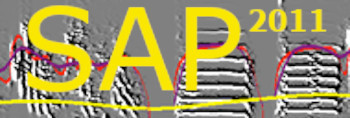Segmented comparisons
| < PREVIOUS: Input & output settings | > NEXT: Saving data criteria |
|
|
|
|
|
|
The segmented comparisons tab allows you to explore two sounds, align segments, play them and compute differences between them. This procedure is conceptually similar to similarity measurements described earlier, but here we are only performing comparisons over the means of features across the two intervals, which does not guarantee that the spectral shapes are similar, but instead provides some overall 'distance' estimates between the two intervals. SAP2011 includes several improvements to the ‘segmented comparisons’ window. First, it is now easier to slide sounds in reference to each other. Clicking just below the sound moves the onset to the mouse position. Double clicking below the sound shifts to ‘sticky mouse’ mode, allowing continuous sliding of the sound. Double clicking again below the sound will release the image.
The next feature you may find useful is auto-alignment: outline an interval in the top sound and then in the bottom sound. You will see that the two outlined intervals have moved to provide perfect alignment. This works nicely using the ‘auto segment a single syllable’ mode (you can set it in either ‘sound 1’ or ‘sound 2’ window). You can then open two song bouts and align syllables to each other in a single click while monitoring changes in the ‘distribution similarity’ score.
Feature distribution scores: based on the MAD table of syllables (see Options -> Feature Normalization -> Normalization of syllable features) we can calculate a distance score, just as we did at the level of frames. When outlining arbitrary intervals of sound, SA+ scores the similarity between them as if they were syllables, which is not very meaningful as a p-value, but still, it can be used as a non-metric score (just as human score is). To obtain a more generic statistical distance estimate, in a way that is not related to any assumption about the distribution of syllables (that is, without any normalization), the Kolmogorov Smironov statistic should be used.
Kolmogorov-Smirnov statistic: is simply the distance between two cumulative histograms. For each given interval, we can calculate the cumulative histogram of feature distribution and compare it to the cumulative distribution of the same feature in the other interval. KS values are unit-less and additive across features. The KS statistic is simple, valid for all species and has very little assumptions in it (in contrast to all other methods we use to score similarity). It does have one major disadvantage, which is – it uses the interval chosen to estimate some ‘momentary’ distribution of features, but this estimate is not robust for short intervals because in a time series of feature values, each feature value is strongly correlated with other feature values (those that occur just prior to, or after it) and this problem cannot be solved by reducing the overlap between features. Therefore, the KS statistic is only meaningful statistically when the two intervals chosen include several syllables. In this case too, you can use the KS statistic between syllables as a non-metric estimate.

